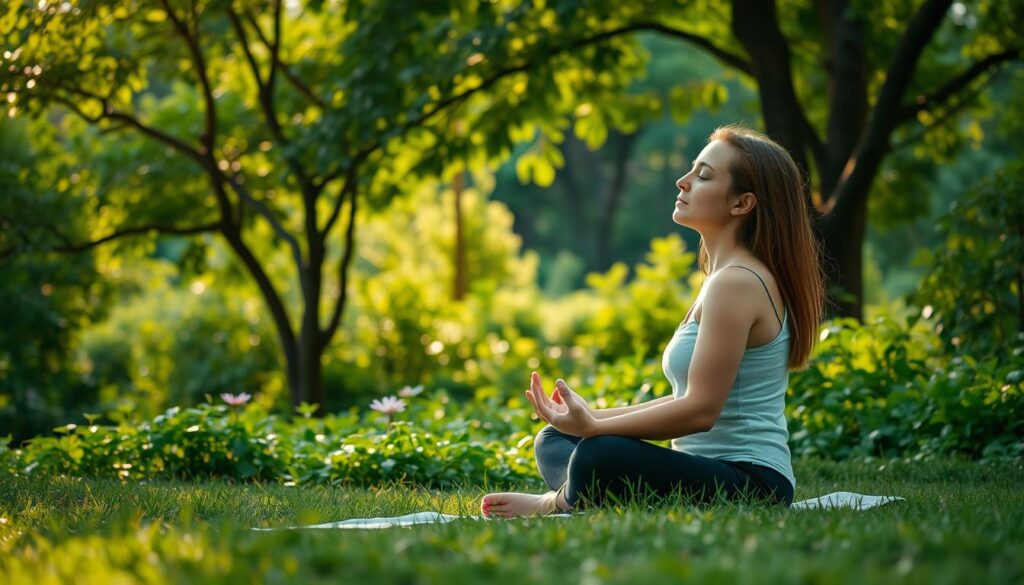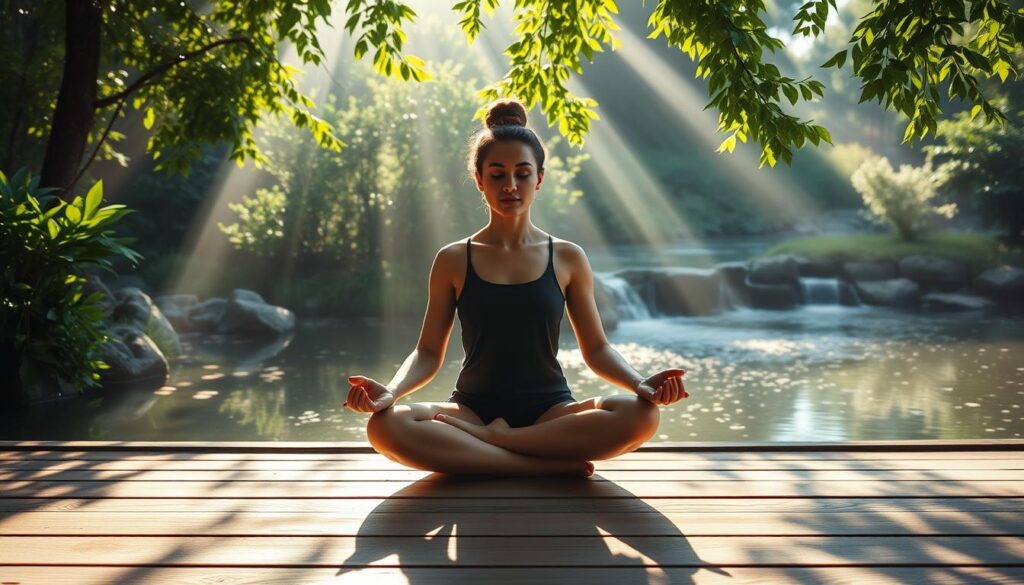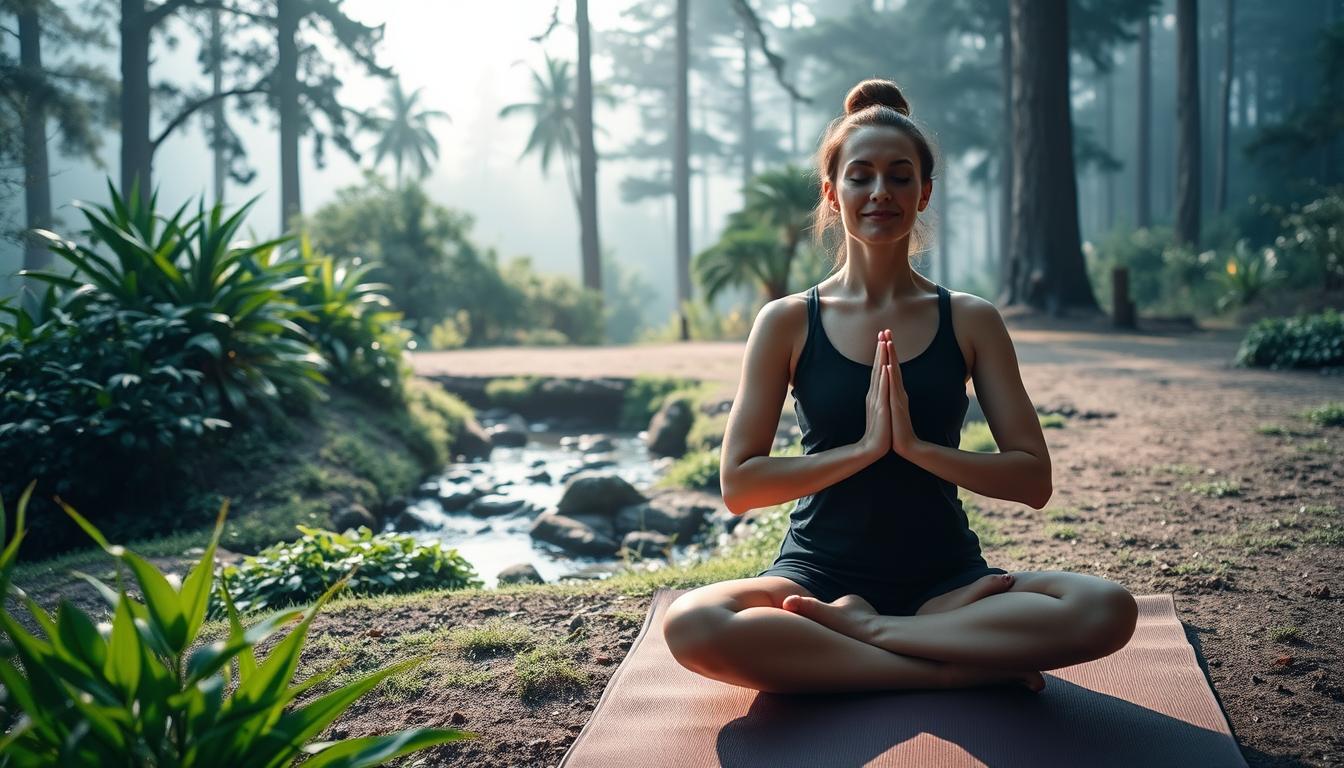In today’s fast-paced world, it’s easy to get caught up in the hustle and bustle of daily life. As someone who’s been there, I know how overwhelming it can feel. That’s where mindfulness comes in – a powerful tool to help you stay grounded and focused.
Meditation is a simple yet effective way to cultivate mindfulness. By focusing your mind on the present moment, you can reduce stress and improve your overall well-being. It’s not about achieving perfect stillness or emptying your mind completely; it’s about developing a healthier relationship with your thoughts.
As you start your practice, you’ll discover that even short sessions can make a significant difference. You’ll be more focused, and your overall well-being will improve. It’s a journey worth taking, and it’s easier than you think.
Key Takeaways
- Discover the basics of meditation and how it can benefit your daily life.
- Learn how to start a practice that suits your lifestyle.
- Understand the importance of being present in the moment.
- Find out how mindfulness can reduce stress and improve focus.
- Develop a healthier relationship with your thoughts.
What is Meditation and Why Practice It?
In a world filled with constant stimulation, meditation offers a rare opportunity to pause and connect with ourselves. As we navigate through our daily lives, we can easily get caught up in the hustle and bustle, leaving us feeling stressed and overwhelmed. This is where meditation comes in – a powerful practice that can help us regain control and bring balance to our lives.
Defining Meditation
Meditation is a practice that involves training our minds to focus and be present in the moment. It is a simple yet powerful tool that can help us reduce stress, improve our mental clarity, and enhance our overall well-being. When we meditate, we inject far-reaching and long-lasting benefits into our lives, from lowering our stress levels to improving our relationships and communication with others.
As we practice meditation, we become more aware of our thoughts, emotions, and physical sensations, allowing us to address them with greater clarity and compassion. This increased awareness can have a significant impact on our daily lives, helping us to make better decisions, be more productive, and enjoy a greater sense of overall well-being.
The Science-Backed Benefits of Regular Practice
Research has consistently shown that regular meditation practice can bring numerous benefits, including reduced stress hormones like cortisol, improved immune function, and increased feelings of happiness and well-being. Studies have found that as little as 12 minutes a day of meditation over an eight-week period can produce noticeable changes in the brain, decrease levels of anxiety, and improve our overall well-being.
Some of the key benefits of regular meditation practice include:
- Reduced stress and anxiety
- Improved sleep quality
- Enhanced focus and productivity
- Improved immune function
- Lower blood pressure
- Reduced inflammation
- Greater resilience when facing life’s challenges
By incorporating meditation into our daily lives, we can experience these benefits firsthand and start to make positive changes to our overall well-being.
Getting Started with Learning Meditation
When I first started meditating, I didn’t know where to begin – but setting up a basic routine made all the difference. As a beginner, it’s essential to start with the basics and build from there. Here, we’ll explore the simple steps you can take to begin your meditation journey.

Creating Your Meditation Space
Creating a dedicated meditation space can help you establish a consistent practice. This space doesn’t have to be large or elaborate; a quiet corner of your room can be just as effective. Make this space your own by adding elements that promote relaxation, such as plants or a meditation cushion.
For example, I have a small meditation area in my home that is simply a cushion placed in a quiet corner, surrounded by some plants. It is straightforward, but it works well for me.
Finding the Right Posture
Finding a comfortable posture is crucial for meditation. You can meditate in any position that you find comfortable, whether that’s on a chair, on a cushion on the floor, or even on your bed. The key is to maintain a posture that keeps you relaxed yet alert.
When I meditate, I prefer to use a cushion on the floor because it helps me maintain a straight back. You can experiment with different postures to find what works best for you.
Setting Realistic Time Expectations
One of the most common questions for meditation beginners is: “How long should I meditate?” If you are new to meditation, I recommend starting with just five minutes each day. As you get more comfortable with the practice, you can gradually increase the time over several weeks.
When starting out, five minutes of meditation can feel challenging, but this is completely normal. Consistency is more important than duration; a daily five-minute practice will yield better results than an occasional 30-minute session. As your practice develops, you’ll likely find that your meditation time naturally extends as you become more comfortable with the experience.
Some key points to keep in mind when setting your meditation time:
- When starting out, five minutes of meditation can feel surprisingly challenging – this is completely normal and doesn’t mean you’re “bad” at meditating.
- Consistency matters more than duration – a daily five-minute practice will yield better results than an occasional 30-minute session.
- Research shows that even brief meditation sessions can produce meaningful benefits, so don’t feel pressured to meditate for long periods right away.
- As your practice develops, you’ll likely find that your meditation time naturally extends as you become more comfortable with the experience.
- Many experienced meditators started with just a few minutes per day and gradually built up to longer sessions over months or years.
- Setting a timer can help remove the distraction of wondering how long you’ve been sitting – many meditation apps include gentle interval bells for this purpose.
- Remember that meditation is a skill that develops over time – be patient with yourself and celebrate the consistency of your practice rather than focusing on duration.
Basic Meditation Techniques for Beginners
As you start your meditation journey, it’s essential to explore various techniques to find what works best for you. With so many methods available, beginners can feel both excited and overwhelmed. Here, we’ll delve into three fundamental techniques to get you started: Breath-Focused Meditation, Body Scan Practice, and Mindful Awareness Technique.
Breath-Focused Meditation
Breath-Focused Meditation is a simple yet powerful technique that involves concentrating on your breath. To practice, find a comfortable seated position, close your eyes, and bring your attention to your breath. Notice the sensation of the air entering and leaving your nostrils. When your mind wanders (and it probably will!), gently acknowledge the thought and return to your breath. This mindfulness practice helps cultivate focus and calmness. Start with short sessions, like 5-10 minutes, and gradually increase as you become more comfortable with the practice.

Body Scan Practice
The Body Scan Practice involves lying down or sitting comfortably and bringing awareness to different parts of your body. Starting from your toes, gradually move your attention up to the top of your head, noticing any sensations, tension, or relaxation. This technique helps you develop awareness of your physical body and release any stored tension. As you practice, you’ll become more attuned to your body’s needs and feel more grounded in the present moment.
| Technique | Primary Focus | Benefits |
|---|---|---|
| Breath-Focused Meditation | Breathing | Improves focus, reduces stress |
| Body Scan Practice | Body sensations | Relaxes the body, increases body awareness |
| Mindful Awareness Technique | Open awareness | Enhances mindfulness, reduces reactivity to thoughts |
Mindful Awareness Technique
Mindful Awareness involves maintaining an open awareness of your experience moment by moment. This includes noticing thoughts, emotions, and physical sensations without judgment. When practicing, you might label your experiences as “thinking,” “feeling,” or “sensation” to create distance and perspective. This technique helps you understand that your thoughts and feelings are temporary and not necessarily reflective of reality. Regular practice can lead to greater emotional resilience and a deeper understanding of yourself in the moment.
By incorporating these techniques into your practice, you’ll be well on your way to developing a meaningful meditation habit. Remember, the key is consistency and patience – allow yourself to explore and grow at your own pace.
Building Your Meditation Routine
Meditation becomes a powerful habit when it’s practiced regularly, and here’s how to make it stick. To integrate meditation into your life, you need to make it a consistent part of your daily routine.
Choosing the Best Time to Meditate
Selecting the right time to meditate can significantly impact your ability to practice consistently. It’s about finding a moment that works for you, whether that’s early in the morning or right before bed. Experiment with different times to see what fits best with your schedule and habits.
Starting Small and Building Consistency
Starting with short meditation sessions can help you build the habit without feeling overwhelmed. Begin with a few minutes a day and gradually increase the duration as you become more comfortable with the practice. Consistency is key to making meditation a lasting part of your life.
Using Reminders and Cues
To maintain your meditation practice, use reminders and cues around you. Place your meditation cushion or yoga mat in a visible spot, and consider using sticky notes or digital reminders. Creating “if-then” messages, like “If I finish brushing my teeth, then I’ll meditate for five minutes,” can also be effective. This simple thing can become a powerful trigger for your meditation routine.

Common Challenges and How to Overcome Them
One of the most significant hurdles in meditation is overcoming the common challenges that many practitioners face. Meditation is about non-judgmental awareness, and it’s essential to approach your practice without expectations. You might feel restless, bored, or calm during a session, but the key is to acknowledge and accept whatever arises.
Dealing with a Wandering Mind
A wandering mind is a common obstacle in meditation. When you find your mind drifting away from your chosen focus, gently acknowledge the thought and return to your breath. It’s not about achieving a blank mind; it’s about cultivating awareness of your thoughts and learning to let them go. As you practice, you’ll become more adept at recognizing when your mind has wandered and refocusing your attention.
Managing Physical Discomfort
Physical discomfort can be a significant distraction during meditation. To minimize this, choose a comfortable seated position or explore alternative methods like lying down or walking meditation. If discomfort arises, take a moment to adjust your position or take a few deep breaths before continuing your meditation practice.
Staying Motivated When “Nothing Happens”
It’s common to feel like you’re not getting anything out of your meditation session. However, the benefits of meditation often manifest in subtle ways, such as increased calm and empathy in daily life. When you feel like “nothing’s happening,” recognize that this awareness is, in fact, a part of the meditation process. By persisting in your practice, you’ll begin to notice positive changes over time.
As the saying goes, “Meditating is not a race to perfection—It’s returning again and again to the breath.” This mindset helps in staying motivated and committed to your meditation journey.
Exploring Different Meditation Styles
When it comes to meditation, there is no single approach that fits all – different styles cater to different needs. As you continue your meditation journey, you might find that certain techniques resonate with you more than others.
Guided Meditation for Beginners
Guided meditation is an excellent starting point, especially for those new to the practice. It involves following the guidance of a teacher or instructor, usually through an app or video, to lead you through a session. Some of the best guided meditations can be found in apps like Headspace or Calm.

Walking Meditation
For those who find it challenging to sit still, walking meditation can be a great alternative. This technique involves paying attention to your steps, the sensation of your feet touching the ground, and the movement of your body as you walk. It brings mindfulness into your daily activity.
Loving-Kindness Meditation
Loving-kindness meditation, also known as Metta, focuses on cultivating feelings of goodwill, kindness, and warmth toward yourself and others. During this practice, you silently repeat phrases like “May I be happy, may I be healthy, may I be safe, may I live with ease,” gradually extending them to others. Some people might feel awkward at first, but over time, this meditation can bring about positive emotional changes. As you practice, you might feel more compassionate and empathetic toward yourself and those around you.
Conclusion: Embracing the Journey of Meditation
Our meditation journey, though coming to an end in this article, is just beginning in our lives. As we practice meditation, we cultivate a different relationship with our mind, based on awareness and kindness.
As we continue on this journey, we realize that meditation is not about achieving a specific state but about being present in the present moment. Every time we sit down to meditate, we are making a statement about our values – presence, awareness, and our own well-being.
With consistent meditation practice, we enhance our capacity for mindfulness and strengthen our ability to navigate life’s challenges with clarity and ease. As we embrace this journey, we step into a life of more awareness, kindness, and connection.
FAQ
What is the best way to start practicing meditation every day?
Start small – just five minutes a day – and make it a habit by incorporating it into your daily routine, like right after waking up or before a meal.
How do I deal with a mind that wanders during practice?
When your mind wanders, gently bring your focus back to your breath or the present moment – don’t worry if it happens often, it’s all part of the process.
What are some common physical discomforts when meditating, and how can I manage them?
You might feel uncomfortable sitting still or experience pain in your back or feet; try using a chair or cushion to support your posture, or switch positions.
How can I stay motivated to keep practicing if I don’t feel like I’m getting any benefits?
Keep in mind that benefits might not be immediate; try to focus on the process, and use guided meditations to keep your practice interesting.
Can I practice mindfulness at times other than when I’m meditating?
Absolutely – you can bring mindfulness into your daily activities like eating or walking by paying attention to the present moment and your experiences.
What is the ideal length of time to meditate each day?
Start with a manageable amount, like five minutes, and gradually increase as you become more comfortable with the practice – some people meditate for 20 minutes or more.
How can I create a good meditation space in my home?
Find a quiet, comfortable spot where you can sit and meditate without distractions – you can make it more inviting with some plants or calming sounds.
